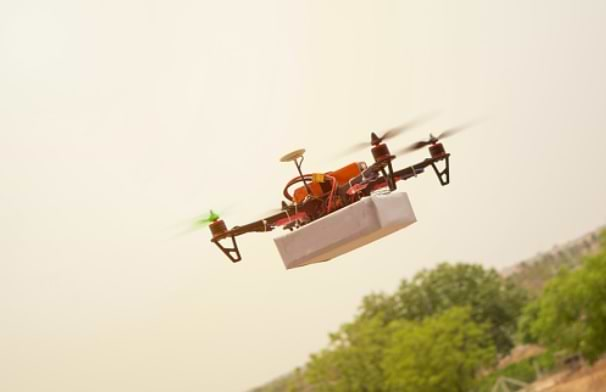
Have you ever wondered how much a drone can carry? I did some deep research and here is what I found.
The carrying capacity of a drone depends entirely on the type of drone you are looking at and what it was designed for. The maximum capacity for a small hobby drone is around 4,4 pounds while the maximum capacity for a professional drone can be up to 485 pounds—it all depends on what you want out of the drone.
Now that you know how much weight the average drone can carry, keep reading below to find out how much weight your drone can carry.
Types of Drones & Weight They Can Carry
Drones come in all sorts of shapes and sizes ranging from copters that can fit in the palm of your hand to larger drones that you can fit inside of— what differentiates them is the type of motor they run off.
| Drone Type: | Paper Lift Weight: | Actual Lift Weight: | Drone Type: | Price: |
| DJI Mavic Pro | 0.9 lbs | 2,2 lbs | Hobby | $800 |
| DJI Phantom 4 | 1 lbs | 4.4 lbs | Hobby | $1500 |
| Yuneec Tornado H920 | 5 lbs | 6 lbs | Professional | $5000 |
| DJI Matrice 600 Pro | 13 lbs | 15 lbs | Professional | $6000 |
| Ehang 184 | 260 lbs | 260 lbs | Person carrier | $300,000 |
| The Griff 300 | 500 lbs | 500 lbs | Person carrier | $250,000 |
Most normal hobby drones have smaller motors, while quad-copters can be designed with larger motors to help with heavy lifting. Similar to the potential speed of different motor cars, it all depends on a lot of factors like the type of car and the laws surrounding the speed limits in the area you are driving.
With that being said, let’s take a look at different types of drones and how much weight they can carry:
DJI Mavic Pro
The DJI Mavic Pro is a small consumer drone that was not built to lift heavy objects. It is a hobby drone so it is mainly used by beginner drone pilots to film scenery, it is not usually required to lift anything as its camera is already attached to the drone. The drone is small and compact, designed to be easily portable and be able to be an on the go type drone.
- Carrying Weight: The Mavic Pro is only supposed to carry around 0.9 pounds but can carry around 2,2 pounds but I do not recommend you try lifting this much weight with the drone.
- Cost: The Mavic Pro comes at a cost price of $800.
DJI Phantom 4
The DJI Phantom 4 is a drone that normal drone enthusiasts around the world use. It is only supposed to lift 1 pound of weight which might not seem like a lot but the primary use for the Phantom 4 is to be an image capturing drone.
- Carrying Weight: The Phantom 4 can lift around 4,4 pounds but again I do not recommend trying to lift this much weight with this type of drone as it was not built to try to lift this kind of weight and you might end up damaging the drone instead.
- Cost: The Phantom 4 is easily accessible to the public and has a cost price of just under $1,500.
Yuneec Tornado H920
The Tornado H920 is a professional multirotor aerial photography and videography drone. This drone is bigger than the average hobby drone and is also known as a Quadcopter.
The Tornado H920 is bigger than the average drone meaning it has a larger motor giving it more power as well as more propellers.
- Carrying Weight: The Tornado H920 has a carrying capacity of up to 5 pounds. Once again the 5-pound carrying capacity is a recommended weight if you do not want to cause any damage to the motors and propellers of the drone.
- Cost: This wonderful drone will cost you around $5000.
DJI Matrice 600 Pro
The Matrice 600 Pro inherited everything from its predecessor the M600 but now it has better flight performance and better loading capacity.
- Carrying Weight: The M600 Pro has a carrying capacity of around 13 pounds in order to support the number of gimbals it effortlessly supports. It is also able to carry a wide range of heavy-duty cameras offered by DJI such as the Zenmuse X7.
- Cost: The Matrice 600 Pro comes at a cost of just under $6000.
To be able to carry this much weight of the gimbal plus the cameras, the drone really needs to be on the larger side and designed to be able to handle the weight.
Ehang 184
This drone is no ordinary drone. It is classified as a Manned UAV and basically provides means of personal transport for a single person not weighing more than 220 pounds.
- Carrying Weight: The Ehang 184 is not supposed to carry a human weighing over 220 pounds but they say it can carry up to 260 pounds but this is not recommended. Obviously, with the ability to carry a human being from one point to another, it has the ability to carry anything else you could be thinking of carrying.
- Cost: Sadly, it comes with a heavy price tag of between $200,000 and $300,000.
The Griff 300
The Griff 300 is a similar drone to the Ehang 184 as it is also capable of lifting a human being and will also soon be used as air travel. Griff Aviation is the company behind the making of this magnificent drone.
- Carrying Weight: This drone can carry up to 500 pounds while still being able to travel at a top speed of 37 mph.
- Cost: The Griff 300 will sadly cost you quite a bit of cash as well, as it comes at a cost price of $250,000 and that is still not even the final price.
INSIDER TIP: If you upgrade the motor in your drone you can increase its power output which can help it lift heavier objects than what it was intended. Another thing you can do is to increase the number of rotors you have on the drone to resemble the design of the hexacopters. The more rotors or propellers a drone has the more capable it will be to lift heavier objects.
They may also be able to carry things that are heavier than what they were intended to carry. There are ways that you can help improve the load capacity of your drone—let’s take a look.
Factors Influencing Drone Carrying Capacity
There are many factors that all affect how much weight a drone is able to carry. Here is a list of the most important factors that affect drones carrying capacity.
- Motor power. The amount of power the motor has affects the ability the drone has to be able to take off with weight attached to it as well as the power to lift its own weight as well.
- Size and number of propellers. The more propellers and the bigger the propellers greatly affects the lift of the drone’s capability to lift objects. If you think of the propellers like a fan, the bigger the blades on the fan the more wind it produces, it is the same for drone propellers.
- Type of battery. Drones that have a much higher requirement when it comes to what they need to lift also need a battery with a bigger capacity, which also adds weight to the drone and therefore they also need a larger motor and larger propellers.
- Weight of the drone itself. The drones that need to have all these added extras in order to lift more weight also need to have a more durable frame in order to protect all this heavy more expensive equipment. The more durable frames are heavier than the standard lightweight frames of hobby drones and because they have this new durable frame the drone will weigh more which will then affect its lifting ability as well.
There are also other factors that affect the drones lifting capability like its battery life that will affect how much time it spends in the air while carrying more weight as well as the ability to maintain control in the air.
Final Thoughts
When it comes to drones the answer will all depend on the size of the drone being mentioned and what it was designed to do. In the future, as the technology in drones improves as well as their design and other aspects, then drones will possibly be able to exceed the limitations of their initial purpose and design. Until then, enjoy your drone and have fun with the features it currently has!
